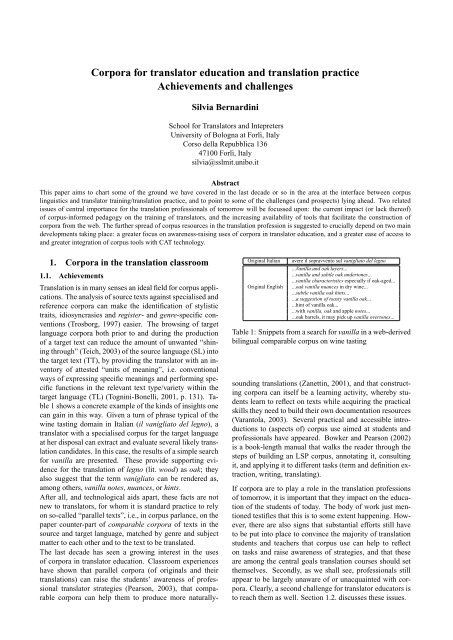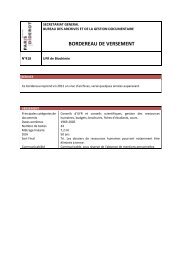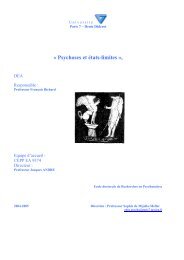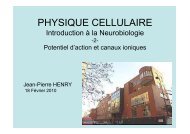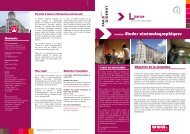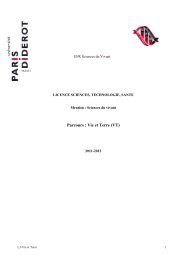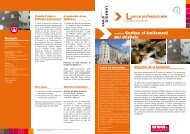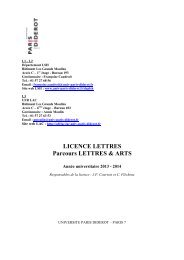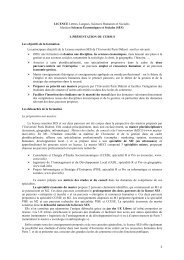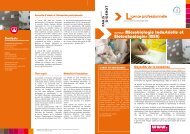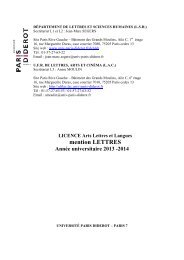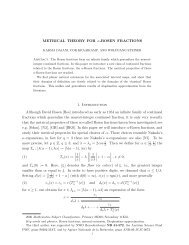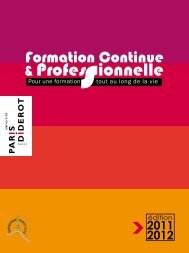Corpora for translator education and translation practice ...
Corpora for translator education and translation practice ...
Corpora for translator education and translation practice ...
You also want an ePaper? Increase the reach of your titles
YUMPU automatically turns print PDFs into web optimized ePapers that Google loves.
<strong>Corpora</strong> <strong>for</strong> <strong>translator</strong> <strong>education</strong> <strong>and</strong> <strong>translation</strong> <strong>practice</strong><br />
Achievements <strong>and</strong> challenges<br />
Silvia Bernardini<br />
School <strong>for</strong> Translators <strong>and</strong> Intepreters<br />
University of Bologna at Forlì, Italy<br />
Corso della Repubblica 136<br />
47100 Forlì, Italy<br />
silvia@sslmit.unibo.it<br />
Abstract<br />
This paper aims to chart some of the ground we have covered in the last decade or so in the area at the interface between corpus<br />
linguistics <strong>and</strong> <strong>translator</strong> training/<strong>translation</strong> <strong>practice</strong>, <strong>and</strong> to point to some of the challenges (<strong>and</strong> prospects) lying ahead. Two related<br />
issues of central importance <strong>for</strong> the <strong>translation</strong> professionals of tomorrow will be focussed upon: the current impact (or lack thereof)<br />
of corpus-in<strong>for</strong>med pedagogy on the training of <strong>translator</strong>s, <strong>and</strong> the increasing availability of tools that facilitate the construction of<br />
corpora from the web. The further spread of corpus resources in the <strong>translation</strong> profession is suggested to crucially depend on two main<br />
developments taking place: a greater focus on awareness-raising uses of corpora in <strong>translator</strong> <strong>education</strong>, <strong>and</strong> a greater ease of access to<br />
<strong>and</strong> greater integration of corpus tools with CAT technology.<br />
1. <strong>Corpora</strong> in the <strong>translation</strong> classroom<br />
1.1. Achievements<br />
Translation is in many senses an ideal field <strong>for</strong> corpus applications.<br />
The analysis of source texts against specialised <strong>and</strong><br />
reference corpora can make the identification of stylistic<br />
traits, idiosyncrasies <strong>and</strong> register- <strong>and</strong> genre-specific conventions<br />
(Trosborg, 1997) easier. The browsing of target<br />
language corpora both prior to <strong>and</strong> during the production<br />
of a target text can reduce the amount of unwanted “shining<br />
through” (Teich, 2003) of the source language (SL) into<br />
the target text (TT), by providing the <strong>translator</strong> with an inventory<br />
of attested “units of meaning”, i.e. conventional<br />
ways of expressing specific meanings <strong>and</strong> per<strong>for</strong>ming specific<br />
functions in the relevant text type/variety within the<br />
target language (TL) (Tognini-Bonelli, 2001, p. 131). Table<br />
1 shows a concrete example of the kinds of insights one<br />
can gain in this way. Given a turn of phrase typical of the<br />
wine tasting domain in Italian (il vanigliato del legno), a<br />
<strong>translator</strong> with a specialised corpus <strong>for</strong> the target language<br />
at her disposal can extract <strong>and</strong> evaluate several likely <strong>translation</strong><br />
c<strong>and</strong>idates. In this case, the results of a simple search<br />
<strong>for</strong> vanilla are presented. These provide supporting evidence<br />
<strong>for</strong> the <strong>translation</strong> of legno (lit. wood) as oak; they<br />
also suggest that the term vanigliato can be rendered as,<br />
among others, vanilla notes, nuances, or hints.<br />
After all, <strong>and</strong> technological aids apart, these facts are not<br />
new to <strong>translator</strong>s, <strong>for</strong> whom it is st<strong>and</strong>ard <strong>practice</strong> to rely<br />
on so-called “parallel texts”, i.e., in corpus parlance, on the<br />
paper counter-part of comparable corpora of texts in the<br />
source <strong>and</strong> target language, matched by genre <strong>and</strong> subject<br />
matter to each other <strong>and</strong> to the text to be translated.<br />
The last decade has seen a growing interest in the uses<br />
of corpora in <strong>translator</strong> <strong>education</strong>. Classroom experiences<br />
have shown that parallel corpora (of originals <strong>and</strong> their<br />
<strong>translation</strong>s) can raise the students’ awareness of professional<br />
<strong>translator</strong> strategies (Pearson, 2003), that comparable<br />
corpora can help them to produce more naturally-<br />
Original Italian<br />
Original English<br />
avere il sopravvento sul vanigliato del legno<br />
...Vanilla <strong>and</strong> oak layers...<br />
...vanilla <strong>and</strong> subtle oak undertones...<br />
...vanilla characteristics especially if oak-aged...<br />
...oak vanilla nuances in dry wine...<br />
...subtle vanilla oak hints...<br />
...a suggestion of toasty vanilla oak...<br />
...hint of vanilla oak...<br />
...with vanilla, oak <strong>and</strong> apple notes...<br />
...oak barrels, it may pick up vanilla overtones...<br />
Table 1: Snippets from a search <strong>for</strong> vanilla in a web-derived<br />
bilingual comparable corpus on wine tasting<br />
sounding <strong>translation</strong>s (Zanettin, 2001), <strong>and</strong> that constructing<br />
corpora can itself be a learning activity, whereby students<br />
learn to reflect on texts while acquiring the practical<br />
skills they need to build their own documentation resources<br />
(Varantola, 2003). Several practical <strong>and</strong> accessible introductions<br />
to (aspects of) corpus use aimed at students <strong>and</strong><br />
professionals have appeared. Bowker <strong>and</strong> Pearson (2002)<br />
is a book-length manual that walks the reader through the<br />
steps of building an LSP corpus, annotating it, consulting<br />
it, <strong>and</strong> applying it to different tasks (term <strong>and</strong> definition extraction,<br />
writing, translating).<br />
If corpora are to play a role in the <strong>translation</strong> professions<br />
of tomorrow, it is important that they impact on the <strong>education</strong><br />
of the students of today. The body of work just mentioned<br />
testifies that this is to some extent happening. However,<br />
there are also signs that substantial ef<strong>for</strong>ts still have<br />
to be put into place to convince the majority of <strong>translation</strong><br />
students <strong>and</strong> teachers that corpus use can help to reflect<br />
on tasks <strong>and</strong> raise awareness of strategies, <strong>and</strong> that these<br />
are among the central goals <strong>translation</strong> courses should set<br />
themselves. Secondly, as we shall see, professionals still<br />
appear to be largely unaware of or unacquainted with corpora.<br />
Clearly, a second challenge <strong>for</strong> <strong>translator</strong> educators is<br />
to reach them as well. Section 1.2. discusses these issues.
1.2. Challenges<br />
1.2.1. Educating educators<br />
It is common <strong>practice</strong> to speak of the instruction of future<br />
<strong>translator</strong>s as “<strong>translator</strong> training”. The term “training” implies<br />
that the abilities <strong>and</strong> competences to be learned are<br />
expected to be acquirable through <strong>practice</strong> with the kinds<br />
of tools <strong>and</strong> tasks one will be faced with during one’s future<br />
professional carreer, in an environment that reproduces<br />
as closely as possible the future work environment. Widdowson<br />
(1984) contrasts the training framework, in which<br />
learners are prepared to solve problems that can be identified<br />
in advance through the application of pre-set or “acquired”<br />
procedures, with the <strong>education</strong> framework, whose<br />
aim is to develop the ability to employ available knowledge<br />
to solve new problems, <strong>and</strong> to gain new knowledge as the<br />
need arises. According to Widdowson, LSP teaching would<br />
be an example of a training setting, while general language<br />
teaching would be an example of an <strong>education</strong>al setting.<br />
We may wonder whether <strong>translator</strong> <strong>education</strong> is in fact<br />
closer to the training or to the <strong>education</strong> end of the cline.<br />
Gouadec (2002, pp. 32ff) explicitly champions the <strong>for</strong>mer<br />
position:<br />
[W]e are supposed to train people to per<strong>for</strong>m<br />
clearly identified functions in clearly identified<br />
environments where they will be using clearly<br />
identified tools <strong>and</strong> “systems”. [...] No serious<br />
<strong>translator</strong> training programme can be dreamt<br />
of unless the training environment emulates the<br />
work station of professional <strong>translator</strong>s. [...]<br />
[T]he curriculum should [...] concentrate on emulating<br />
the actual work conditions of language<br />
services providers.<br />
These views are certainly not unusual, <strong>and</strong> indeed are rather<br />
popular with students <strong>and</strong> prospective employers, who often<br />
lament a limited role of technology in <strong>translator</strong> <strong>education</strong>.<br />
While I am obviously sympathetic to the general<br />
issue of technology in the <strong>translation</strong> classroom, I think it<br />
would be dangerous to carry these views to their extreme<br />
consequences, <strong>for</strong> two main reasons.<br />
First, if <strong>translation</strong> skills are best taught by simulating actual<br />
work conditions, we should ab<strong>and</strong>on the idea of <strong>education</strong><br />
<strong>for</strong> <strong>translator</strong>s (something that even Gouadec would<br />
probably not want to suggest) <strong>and</strong> turn to apprenticeship<br />
instead: a professional environment should arguably provide<br />
a more appropriate setting <strong>for</strong> the simulation of actual<br />
work conditions than an academic one. Second, <strong>and</strong> more<br />
importantly, actual work conditions - <strong>and</strong> time pressure in<br />
particular - require that <strong>translator</strong>’s strategies have become<br />
proceduralised, as is the case with mature professionals.<br />
Jääskeläinen (1997) finds that semi-professionals (<strong>translator</strong><br />
trainees) show more extensive processing than both professionals<br />
<strong>and</strong> non-professionals. She suggests that this<br />
may be because they are aware of the problems involved<br />
but have not yet automatised the necessary problem-solving<br />
strategies. Automatic processes are typically very efficient<br />
but little flexible, such that there is the danger, pointed out<br />
e.g. by Wills (1994, p. 144), “of problems being <strong>for</strong>ced into<br />
a certain structure, because it is believed to offer a solution”.<br />
In an <strong>education</strong> setting, students are still to develop<br />
the strategies that will then become proceduralised. Forcing<br />
them to work under realistic time constraints as would happen<br />
in a simulation activity could there<strong>for</strong>e work against<br />
the development of professionality.<br />
Translation instruction viewed as <strong>education</strong>, on the other<br />
h<strong>and</strong>, would make time <strong>for</strong> just the kind of activities <strong>and</strong><br />
reflections that future professional <strong>translator</strong>s will not have<br />
time <strong>for</strong>. A challenging aspect that is often neglected is how<br />
we can teach our students to identify problems in the first<br />
place. Going back to Gouadec (2002, p. 33), he claims that<br />
professional <strong>translator</strong>s should possess, among others, the<br />
following skills:<br />
1. Fully underst<strong>and</strong> material to be translated<br />
2. Detect, interpret <strong>and</strong> cope with cultural gaps [...]<br />
3. Transfer in<strong>for</strong>mation, facts, concepts [...]<br />
4. Write <strong>and</strong> rewrite<br />
5. Proofread<br />
6. Control <strong>and</strong> assess quality<br />
These skills translate into know-how; <strong>translator</strong>s should<br />
know how to:<br />
1. Get the in<strong>for</strong>mation <strong>and</strong> knowledge required<br />
2. Find the terminology<br />
3. Find the phraseology<br />
4. Translate<br />
5. Proofread<br />
6. Rewrite<br />
7. Manage their task(s)<br />
8. Manage a project (<strong>and</strong> other people)<br />
Comparing the two lists, one notices that neither item 1 nor<br />
item 2 in the first (the “skills” list) translate into any of the<br />
know-hows in the second. In other words, there is a gap between<br />
“fully underst<strong>and</strong> the material/detect any gaps etc.”<br />
<strong>and</strong> “getting the in<strong>for</strong>mation <strong>and</strong> knowledge required”.<br />
While illustrating this point with sufficient detail would<br />
take more space than is available here, a simple example<br />
can be provided. The phrases in the first column of Table<br />
2 are taken from the Time Out Barcelona Guide (2002,<br />
Penguin). They are all titles of short sections devoted to<br />
different events or places, <strong>and</strong> they all involve wordplay. In<br />
these cases, to “fully underst<strong>and</strong> the material to be translated”<br />
one needs to underst<strong>and</strong> the relationship between<br />
the facts being recounted or places being described <strong>and</strong> the<br />
lexicalised expressions used. While the texts themselves<br />
no doubt provide hints <strong>for</strong> getting at the more “congruent”<br />
sense, the less congruent sense is normally not as easily inferrable<br />
from the texts, since it is assumed to be available<br />
to the reader (this is in fact a precondition <strong>for</strong> the success of<br />
the wordplay). A student who is not aware of these layers
Title Topic Senses<br />
Get into the Montserrat Monastery in the habit of doing something:<br />
habit<br />
having a habit [...] of so doing.<br />
So to [...] get into the habit (OED)<br />
the habit, monastic order<br />
or profession (OED)<br />
Getting high Castells high: under the influence<br />
(human towers) of drugs or alcohol (OED)<br />
Death on the Montjuïc James Still poem<br />
mountain (site of executions) Japanese movie<br />
On the tiles The work of on the tiles: on a spree,<br />
Architect<br />
on a debauch (OED)<br />
J.M. Jujol<br />
Josep Maria Jujol:<br />
Catalan architect,<br />
his activity ranged<br />
from furniture designs<br />
<strong>and</strong> painting, to<br />
architecture (wikipedia)<br />
Table 2: Titles <strong>and</strong> senses: wordplay in the Barcelona Time<br />
Out Guide<br />
of meaning may be misled into taking such expressions as<br />
on the tiles <strong>and</strong> getting high at face value only.<br />
While it is easy to find out about these expressions, i.e. “get<br />
the in<strong>for</strong>mation <strong>and</strong> knowledge required” with the resources<br />
currently available to any <strong>translator</strong>, I am arguing<br />
that the real <strong>and</strong> often underestimated challenge lies<br />
in teaching students to identify wordplay or other types of<br />
“layered” meaning in the first place. By drawing their attention<br />
to regularities in language per<strong>for</strong>mance as displayed<br />
in corpora, <strong>and</strong> making them reflect on the implications<br />
of (un)conventional usages, corpus-based activities such as<br />
those described in Sinclair (2003), Stubbs (2001) <strong>and</strong> Hoey<br />
(2005), especially if set within a <strong>translation</strong>-relevant framework,<br />
could help to fill this gap in <strong>translation</strong> pedagogy.<br />
1.2.2. In<strong>for</strong>ming professionals<br />
While sensitising students <strong>and</strong> instructors is of great importance<br />
<strong>for</strong> reaching the professionals of tomorrow, we should<br />
not <strong>for</strong>get the professionals of today. Reading about <strong>translation</strong><br />
aids, one seldom finds references to corpora <strong>and</strong> concordancing<br />
tools. This impression is confirmed by surveys<br />
attempting to find out whether professional <strong>translator</strong>s are<br />
aware of the existence of corpora, <strong>and</strong> to what extent they<br />
use them in their work.<br />
Surveying the Canadian market, Bowker (2004) finds that<br />
professional associations are aware of the existence of corpora,<br />
but are generally more interested in <strong>translation</strong> memory<br />
(TM) technology, <strong>and</strong> that job advertisements never<br />
mention corpora.<br />
A more thorough investigation of the perception professional<br />
<strong>translator</strong>s have of corpora is being conducted in<br />
the framework of the LEONARDO-funded MeLLANGE<br />
project, as part of an attempt to define user needs <strong>for</strong> learning<br />
materials on <strong>translation</strong> technology. 1 In the first round<br />
of submissions 623 questionnaires were returned, 90.8% of<br />
which completed by professional <strong>translator</strong>s from the UK<br />
(the majority), France, Germany <strong>and</strong> Italy, <strong>and</strong> 9.2 by students<br />
of <strong>translation</strong> in the same countries. Out of the total<br />
respondents, 40.5% reported collecting reference materials,<br />
<strong>and</strong> more than half of them specified that they collect texts<br />
in eletronic <strong>for</strong>mat (69.4% of those who reported collect-<br />
1 http://mellange.upf.es/<br />
ing materials). 46.9% read these collections of texts (rather<br />
than searching through them), <strong>and</strong>, of those who do search<br />
through them, a majority use search facilities in word processors<br />
(65.9%), with only a minority using a concordancer<br />
(19%, recall that data are <strong>for</strong> professionals <strong>and</strong> students).<br />
While many <strong>translator</strong>s are not acquainted with corpora,<br />
there seems to be widespread interest in learning more<br />
about them: 78.6% of respondents would be interested in a<br />
service which provides domain specific corpora, 77.9% in a<br />
tool <strong>for</strong> extracting terms from corpora, <strong>and</strong> 82.4% in learning<br />
more about their potential (MeLLANGE, 2005) (results<br />
are summarised in Table 3). Thus, there is clearly a need<br />
<strong>for</strong> tailor-made learning materials addressed to <strong>translation</strong><br />
professionals, which highlight the value added of corpora<br />
with respect to other tools <strong>and</strong> resources, <strong>and</strong> which adopt<br />
a practical (but not uncritical) perspective.<br />
2.1. Achievements<br />
2. Building corpora<br />
Bowker (2004) mentions different possible reasons why<br />
corpora <strong>and</strong> corpus analysis have not as yet received an enthusiastic<br />
welcome in the professional world. One of these<br />
is the fact that the design, compilation <strong>and</strong> exploitation of<br />
corpora can be very time-consuming while not providing a<br />
tangible immediate increase in productivity. The success of<br />
<strong>translation</strong> memories is instead partly explainable because<br />
both their creation <strong>and</strong> their consultation require minimal<br />
ef<strong>for</strong>t. Similarly, the fact that a large majority of the questionnaire<br />
respondents (above) reported consulting the Web<br />
through Google (93.4%), despite several drawbacks (that<br />
most of them are aware of), suggests that, <strong>for</strong> corpora to be<br />
successful with <strong>translation</strong> professionals, their construction<br />
<strong>and</strong> use has to be made substantially easier <strong>and</strong> faster.<br />
One of the achievements of the past decade has certainly<br />
been the creation of tools that facilitate the extraction of<br />
textual in<strong>for</strong>mation from the World Wide Web in ways that<br />
are more amenable to linguistic analysis. While search engines<br />
such as Google provide fast <strong>and</strong> effective retrieval of<br />
in<strong>for</strong>mation from the Web, they are less than ideal when<br />
it gets to basic linguistic procedures such as highlighting<br />
patterns (i.e. sorting results) or selecting subsets of solutions,<br />
not to mention conducting searches <strong>for</strong> linguisticallyannotated<br />
sequences (e.g. all verb lemmas preceding a certain<br />
noun lemma) (Thelwall, 2005).<br />
A solution to some of these problems has been provided<br />
by tools like Fletcher’s KWiCFinder (Fletcher, 2004),<br />
an online concordancer that supports regular expressions,<br />
implements concordance-like displays <strong>and</strong> functionalities<br />
(e.g. sorting), <strong>and</strong> allows off-line perusal of the retrieved<br />
texts. Along similar lines, another freely available tool,<br />
Matthias Hüning’s TextStat concordancer 2 , allows one to<br />
specify a URL <strong>and</strong> retrieve a file or set of files from a single<br />
website directly from within the concordancer, thus conflating<br />
<strong>and</strong> speeding up the processes of retrieving <strong>and</strong> searching<br />
texts.<br />
While KWiCFinder is designed mainly with language<br />
learning applications in mind (searching <strong>for</strong> a given word<br />
2 http://www.niederl<strong>and</strong>istik.fu-berlin.de/<br />
textstat/software-en.html
Do you collect domain<br />
specific texts?<br />
How do you collect them?<br />
How do you use them?<br />
Do you use corpora in your<br />
<strong>translation</strong> <strong>practice</strong>?<br />
If yes, do you use?<br />
What do you use to search them?<br />
If you do not use corpora, why?<br />
Would you be interested in a<br />
service which quickly provides<br />
domain- <strong>and</strong> language-specific<br />
corpora tailored to your needs?<br />
Would you be interested in a tool<br />
<strong>for</strong> extracting terms from a<br />
domain-specific corpus?<br />
Would you be interested in learning<br />
more about the potential<br />
that corpora offer?<br />
59.5% No<br />
40.5% Yes<br />
69.4% In electronic <strong>for</strong>m<br />
30.6% On paper<br />
53.1% Search through with software<br />
46.9% Read them<br />
60.2% No<br />
39.8% Yes<br />
26.1% <strong>Corpora</strong> of the target language<br />
23.1% <strong>Corpora</strong> of the source language<br />
19.7% Parallel corpora<br />
15.3% Domain specific corpora<br />
13.6% Comparable corpora<br />
2.3% General language corpora<br />
65.9% Search facility in word processor<br />
19.0% Concordancer<br />
14.4% Other search tools<br />
(specify: Trados, Concordance in <strong>translation</strong> memory)<br />
0.7% UNIX utilities<br />
41.9% Never heard about them<br />
19.9% I don’t have time to build them<br />
17.8% I don’t know how to use a concordancer<br />
8.7% I can’t see any advantage over Google<br />
6.8% I can’t see any advantage over <strong>translation</strong> memories<br />
5.0% Other<br />
(1 specified - Not sure if it will work with Macintosh)<br />
78.6% Yes<br />
21.4% No<br />
77.9% Yes<br />
22.1% No<br />
82.4% Yes<br />
17.6% No<br />
Table 3: Corpus section of MeLLANGE questionnaire (first round, closed questions)<br />
or expression as one would search the Internet), <strong>and</strong> Text-<br />
Stat only offers basic web-search facilities (i.e. it does not<br />
interact with a search engine, but simply spiders a specified<br />
URL), the BootCaT toolkit 3 (Baroni <strong>and</strong> Bernardini, 2004)<br />
was created specifically <strong>for</strong> <strong>translation</strong> students <strong>and</strong> professionals,<br />
i.e. <strong>for</strong> users who need relatively large <strong>and</strong> varied<br />
corpora (typically of about 1-2 million words), <strong>and</strong> who are<br />
likely to search the corpus repeatedly <strong>for</strong> both <strong>for</strong>m- <strong>and</strong><br />
content-oriented in<strong>for</strong>mation within a single extended task.<br />
Starting from a series of “seeds” (search words), this set of<br />
Perl scripts provide facilities <strong>for</strong> combining the seeds into<br />
sequences, submitting queries to Google, retrieving URLs<br />
(<strong>for</strong> manual inspection if necessary) <strong>and</strong> eliminating duplicates.<br />
Then <strong>for</strong> each URL the text is retrieved, cleaned, <strong>and</strong><br />
printed to a text file. This procedure can be iterated if larger<br />
corpora are required, e.g. selecting seeds <strong>for</strong> a second round<br />
of searches from the initial corpus <strong>and</strong> repeating the various<br />
steps. These tools have been used <strong>for</strong> several projects,<br />
3 http://sslmit.unibo.it/˜baroni<br />
including the construction of Internet corpora <strong>for</strong> several<br />
languages (see Sharoff’s website 4 <strong>and</strong> Ueyama (<strong>for</strong>thcoming)).<br />
The results in Table 1 were derived from a comparable corpus<br />
of English <strong>and</strong> Italian texts on wine tasting collected<br />
with BootCaT <strong>and</strong> used in an English to Italian <strong>translation</strong><br />
course at the School <strong>for</strong> Translators <strong>and</strong> Interpreters<br />
of the University of Bologna, Italy. The conventions of this<br />
genre both in English <strong>and</strong> in Italian are unknown to virtually<br />
all the students in this course. A specialised comparable<br />
corpus is indespensable to (learn to) search <strong>for</strong> genrerestricted<br />
phraseology <strong>and</strong> terminology, two of the central<br />
know-hows identified by Gouadec (above). Given the time<br />
constraints under which <strong>translator</strong>s normally operate, mastering<br />
techniques <strong>for</strong> the quick-<strong>and</strong>-dirty construction of<br />
corpus resources could be an additional asset.<br />
4 http://www.comp.leeds.ac.uk/ssharoff/
2.2. Challenges<br />
While the new tools at our disposal make the construction<br />
of corpora from the Web easier <strong>for</strong> <strong>translator</strong>s, certain obstacles<br />
still have to be overcome. First, the BootCaT toolkit<br />
at the moment requires basic Unix skills <strong>and</strong> access to a<br />
Unix server. A Web interface is a crucial next step if these<br />
tools are to reach the average <strong>translator</strong>.<br />
In the longer term, widespread use of corpora <strong>and</strong> corpus<br />
construction <strong>and</strong> search facilities is likely to depend on their<br />
integration with Computer-Aided Translation (CAT) technology.<br />
We could envisage a tool that interacted with a Web<br />
search engine to search, retrieve <strong>and</strong> POS annotate corpora<br />
based on user specifications. It would support regular expressions<br />
<strong>and</strong> h<strong>and</strong>le subcorpora, <strong>and</strong> would provide facilities<br />
<strong>for</strong> monolingual <strong>and</strong> parallel concordancing (including<br />
alignment). Such a tool would extend the productivity<br />
of CAT systems by allowing a double search mode: fully<br />
automatic matching <strong>for</strong> golden-st<strong>and</strong>ard TMs, <strong>and</strong> manual<br />
concordancing of comparable <strong>and</strong> parallel texts <strong>for</strong> hypothesis<br />
development <strong>and</strong> testing where the TM has nothing to<br />
contribute:<br />
[...] <strong>translator</strong>s working with texts that contain a<br />
large number of repeated segments, such as revisions,<br />
will be well served by the segment processing<br />
approach. On the other h<strong>and</strong>, <strong>translator</strong>s who<br />
hope to leverage or recycle in<strong>for</strong>mation from previous<br />
<strong>translation</strong>s that are from the same subject<br />
field, but that are not revisions, may find that the<br />
bilingual concordancing approach is more productive.<br />
(Bowker, 2002, p. 124)<br />
Such a system would also arguably limit some of the drawbacks<br />
associated with the use of TM. It has been observed<br />
(e.g. by Kenny (1999) <strong>and</strong> Bowker (2002)) that <strong>translator</strong>s<br />
using CAT software may develop a tendency to make their<br />
texts more easily recyclable within a TM, regardless of the<br />
<strong>translation</strong> brief, <strong>and</strong> that they may be led to lose sight of<br />
the notion of “text” as a consequence of a rigid subdivision<br />
into units. The possibility to search whole texts (rather than<br />
<strong>translation</strong> units) using a concordancer could positively impact<br />
on these strategies <strong>and</strong> attitudes.<br />
While no tool currently combines all these functionalities,<br />
some <strong>for</strong>m of integration seems to be underway, thanks<br />
to tools such as MultiTrans, 5 a commercial CAT package<br />
which allows one to search <strong>for</strong> strings of any length (i.e. not<br />
limited to the size of a <strong>translation</strong> unit), <strong>and</strong>, if required,<br />
displays them in full-text context. Interestingly, while the<br />
company producing this software is called Multicorpora,<br />
no further mention of corpora can be found on the Multitrans<br />
page: yet another proof that corpora are currently not<br />
a buzzword in the <strong>translation</strong> market?<br />
3. Summing up: prospects <strong>for</strong> the future<br />
Despite achievements <strong>and</strong> enthusiasm within academic settings,<br />
corpora are still to make an impact on the <strong>translation</strong><br />
profession. A number of reasons why this might be the<br />
case have been suggested, <strong>and</strong> several challenges have been<br />
identified.<br />
5 http://www.multicorpora.ca/<br />
There seem to be three main areas where ef<strong>for</strong>ts should be<br />
concentrated. First, the role of corpus work <strong>for</strong> awarenessraising<br />
purposes should be emphasised over the more obvious<br />
documentation role, <strong>and</strong> the importance of basic “<strong>translation</strong>”<br />
skills be restored to its central place in <strong>translator</strong><br />
<strong>education</strong>:<br />
[...] the general abilities to be taught at school<br />
[...] are the abilities which take a long time to<br />
learn: text interpretation, composition of a coherent,<br />
readable <strong>and</strong> audience-tailored draft <strong>translation</strong>,<br />
research <strong>and</strong> checking, correcting. [...] If<br />
you cannot translate with pencil <strong>and</strong> paper, then<br />
you can’t translate with the latest in<strong>for</strong>mation<br />
technology. (Mossop, 1999)<br />
Second, <strong>translator</strong>-oriented (e-)learning materials have to<br />
be provided, so as to reach those professionals who are eager<br />
to learn about corpora. These materials should ideally<br />
be contrastive in focus (i.e., why/when use corpora instead<br />
of the Web/TMs/Dictionaries?). They should also include<br />
substantial <strong>practice</strong> primarily with those tools <strong>and</strong> facilities<br />
that <strong>translator</strong>s (rather than linguists or language learners)<br />
are likely to find of immediate relevance (e.g., concordancing<br />
should arguably be given priority over frequency wordlisting).<br />
Finally, corpus construction <strong>and</strong> corpus searching<br />
tools should be made more user-friendly, <strong>and</strong> ideally integrated<br />
with CAT tools.<br />
4. References<br />
M. Baroni <strong>and</strong> S. Bernardini 2004. BootCaT: Bootstrapping<br />
<strong>Corpora</strong> <strong>and</strong> Terms from the Web. Proceedings of<br />
LREC 2004, pp. 1313-1316.<br />
L. Bowker. 2002. Corpus Resources <strong>for</strong> Translators. In<br />
S. Tagnin, editor <strong>Corpora</strong> <strong>and</strong> Translation, TradTerm 10<br />
Special Issue.<br />
L. Bowker. 2004. Computer-aided Translation Technology.<br />
Ottawa: University of Ottawa Press.<br />
L. Bowker <strong>and</strong> J. Pearson. 2002. Working with Specialized<br />
Language. A Guide to Using <strong>Corpora</strong>. London: Routledge.<br />
W. Fletcher. 2004. Facilitating the Compilation <strong>and</strong> Dissemination<br />
of Ad-hoc Web <strong>Corpora</strong>. In G. Aston, S.<br />
Bernardini <strong>and</strong> D. Stewart, editors, <strong>Corpora</strong> <strong>and</strong> language<br />
learners, Amsterdam: Benjamins.<br />
D. Gouadec. 2002. Training Translators: Certainties, Uncertainties,<br />
Dilemmas. In B. Maia, J. Haller <strong>and</strong> M. Ulrych,<br />
editors, Training the Language Services Provider<br />
<strong>for</strong> the New Millennium, Oporto: Universidade do Porto,<br />
pp. 31-41.<br />
M. Hoey. 2005. Lexical priming. London: Routledge.<br />
R. Jääskeläinen. 1997. Tapping the Process: An Explorative<br />
Study of the Cognitive <strong>and</strong> Affective Factors Involved<br />
in Translating. Doctoral dissertation. Joensuu:<br />
University of Joensuu.<br />
D. Kenny. 1999. CAT Tools in an Academic Environment.<br />
Target, 11(1), pp. 65-82.<br />
MeLLANGE. 2005. <strong>Corpora</strong> <strong>and</strong> E-learning Questionnaire:<br />
Results Summary. Internal document, 20.06.05.
B. Mossop. 1999. What Should be Taught at Translation<br />
School? In A. Pym, editor, Innovation in Translator<br />
<strong>and</strong> Interpreter Training - An Online Symposium.<br />
online: http://www.fut.es/ apym/symp/mossop.html [visited:<br />
23.02.06]<br />
K. Pearson. 2003. Using Parallel Texts in the Translator<br />
Training Environment. In F. Zanettin, S. Bernardini<br />
<strong>and</strong> D. Stewart, editors, <strong>Corpora</strong> in <strong>translator</strong> <strong>education</strong>,<br />
Manchester: StJerome, pp. 15-24.<br />
J. McH. Sinclair. 2003. Reading Concordances. London:<br />
Longman.<br />
M. Stubbs. 2001. Words <strong>and</strong> Phrases. London: Blackwell.<br />
E. Teich. 2003. Cross-linguistic Variation in System <strong>and</strong><br />
Text. Berlin: Mouton.<br />
M. Thelwall. 2005. Creating <strong>and</strong> Using Web <strong>Corpora</strong>.<br />
International Journal of Corpus Linguistics, 10(4), pp.<br />
517-541.<br />
E. Tognini-Bonelli. 2001. Corpus Linguistics at Work.<br />
Amsterdam: Benjamins.<br />
A. Trosborg. 1997. Text Typology: Register, Genre <strong>and</strong><br />
Text Type. In A. Trosborg, editor, Text Typology <strong>and</strong><br />
Translation, Amsterdam: Benjamins, pp. 3-23.<br />
M. Ueyama. <strong>for</strong>thcoming. Evaluation of Japanese Webbased<br />
Reference <strong>Corpora</strong>. In M. Baroni <strong>and</strong> S. Bernardini,<br />
editors, Wacky! Working Papers on the Web as Corpus,<br />
Bologna: Gedit.<br />
K. Varantola. 2003. Translators <strong>and</strong> Disposable <strong>Corpora</strong>.<br />
in F. Zanettin, S. Bernardini <strong>and</strong> D. Stewart, editors, <strong>Corpora</strong><br />
in Translator Education, Manchester: StJerome,<br />
pp. 55-70.<br />
H.G. Widdowson. 1984. English in Training <strong>and</strong> Education.<br />
Explorations in Applied Linguistics II, Ox<strong>for</strong>d: Ox<strong>for</strong>d<br />
University Press, pp. 201-212.<br />
W. Wills. 1994. A Framework <strong>for</strong> Decision-making in<br />
Translation. Target, 6(2), pp. 131-150.<br />
F. Zanettin. 2001. Swimming in Words. In G. Aston, editor,<br />
Learning with <strong>Corpora</strong>, Houston, TX: Athelstan, pp.<br />
177-197.


